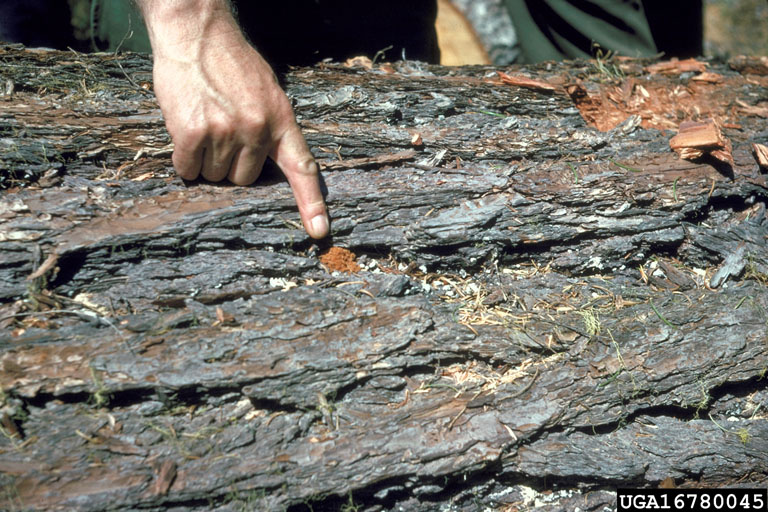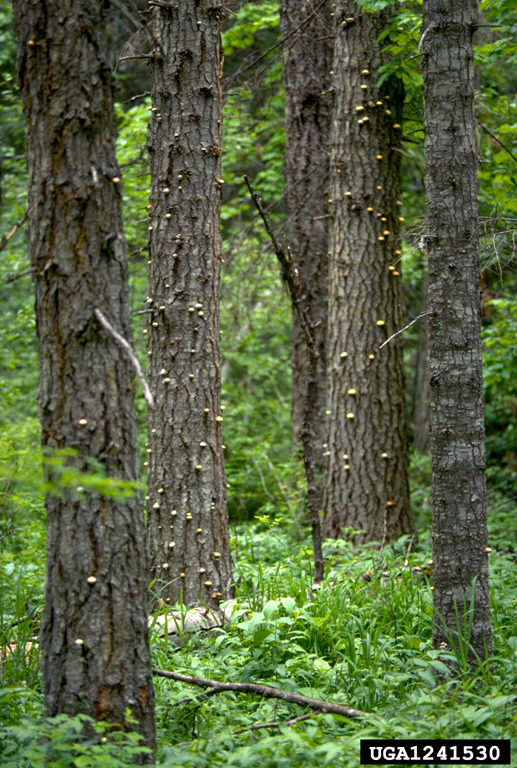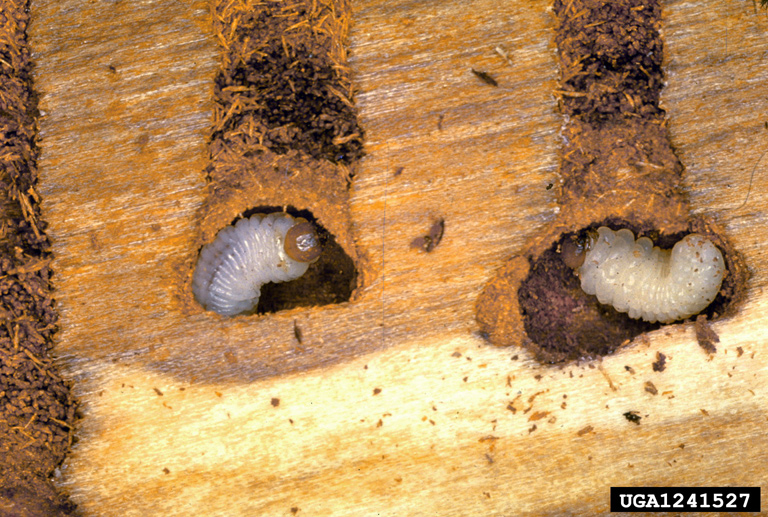Douglas-Fir Beetle
Dendroctonus pseudotsugae
Key Wildlife Value:
The Douglas-fir beetle creates Douglas-fir snags, generally preferring larger trees above 30 to 36 cm (12 to 14 in) dbh. Trees are killed individually and in groups. Canopy gaps and eventually concentrations of down wood result when mortality is aggregated. When gaps are large enough, release of understory trees and shrubs increases structural diversity, and, depending upon initial stand characteristics, at times may increase the diversity of shrub and tree species present the mid- and upper canopy layers. Woodpeckers do not appear to forage to a great extent on Douglas-fir beetles or their larvae, however, they forage considerably on the wood borer larvae that develop in trees after they have been killed by Douglas-fir beetles.
Distribution in Oregon and Washington:
Found throughout both states.
Hosts:
Douglas-fir; occasionally western larch growing intermingled with Douglas-fir is attacked, but standing trees are not killed. Only in fresh down larch is brood production successful.
Diagnosis:
Single trees may be killed, but groups of trees are also frequently killed, especially during outbreaks.




During winter, mostly adults as well as a small proportion of small, white, grub-like larvae may be found beneath the bark of trees attacked the preceding year.
Adults are small (about 6 mm long), stout, somewhat cylindrical, and blackish beetles with reddish elytra, clubbed antennae, and rounded posteriors. Larvae are white legless grubs with brown heads. Pupae are soft and white, with body forms that somewhat resemble adults.


Life History:
Parent beetles work in pairs to construct egg galleries. Females deposit tiny white eggs into small niches on the sides of the egg gallery, alternately laying a set of 10 to 36 eggs on one side of the gallery, then switching to the other side to deposit the next set. Some adults reemerge after establishing a first brood to establish a second brood in another tree. After hatching, larvae tunnel away from the egg gallery, feeding on the phloem. Before pupation, larvae construct pupal cells at the ends of the larval mines. Larvae transform to pupae, and then adults, within these cells. The new adults (new adults are yellow-tan to golden in color, and darken as they mature) excavate between the pupal cells and congregate, sometimes for long periods, beneath the bark before emerging to attack other trees.
The Douglas-fir beetle has a one-year life cycle with “overlapping” generations. The main flight occurs in the spring during April, May, or early June, beginning whenever air temperatures exceed 15°C (60°F), and a second, much smaller flight occurs again in July and August. Most of the mortality associated with Douglas-fir beetle is caused by the spring flight of beetles. The spring flight is comprised of beetles that overwintered as adults (generation A), and the smaller summer flight consists of those beetles that spent the winter as larvae (generation B), as well as spring parents (generation A) that reemerge to establish a second brood.
Important Habitats and Outbreak Dynamics:
Adults colonize fresh down material and living trees, preferring trees with boles that are larger than 36 cm (14 in) dbh west of the Cascades crest (Westside), and larger than 30 cm (12 in) dbh farther east (Eastside). Fresh down material provides nearly ideal conditions for brood survival. Because their numbers are not sufficient to overcome the natural defenses of healthy trees, non-outbreak populations of Douglas-fir beetle use windfalls and weakened trees as their primary habitat.
Group mortality caused by the Douglas-fir beetle tends to form discreet patches. The number of trees killed in a group tends to be higher during outbreaks, and varies with the continuity and extent of susceptible breeding material, the abundance of beetles, and weather conditions.
On the Westside, regional Douglas-fir beetle outbreaks typically develop following severe wind and snow storm events that cause widespread windthrow and stem breakage. Most of these precipitating storm events occur during fall and winter months. The following spring, emerging beetles attack the down material, and because brood survival is very high, populations increase rapidly. If additional windfall is not available when the broods that develop in the down material emerge during spring one year later, the beetles emerging from the down material attack standing trees en masse, frequently killing apparently healthy trees. Westside outbreaks typically last no longer than three to four years, with mortality peaking during the summer one to one and a half years after the precipitating storm event. Because it often takes one year for the foliage of beetle-killed Douglas-fir to fade from green to red, mortality often is not very apparent until the summer occurring two to two and a half years after the precipitating storm event.
Stand density does not appear to be associated with rates of attack in Westside situations; rather, the availability of fresh down host material, beetle population levels, and to some degree, proximity to attacked down material or trees, are the factors exerting the greatest influence. As a general rule, it is estimated that for every 10 down trees that become infested with Douglas-fir beetle following an event that places abundant fresh host material on the ground, six standing green trees are subsequently killed over the next two to three years. Rules of thumb regarding attack rates in standing trees during subsequent outbreak years, for application where fresh down trees equal or exceed a threshold of three trees per acre, are as follows: during the year beetles emerge from down material, roughly one tree is killed for every two down trees; the following year, one tree is killed for every four trees killed the previous year; and the next year, one tree is killed for every 25 trees killed the previous year. With no additional inputs to fresh down material, beetle populations subside to normal levels by the fourth year.
Outbreaks tend to last longer on the Eastside, sometimes continuing as long as six to eight years, especially during droughty periods. Stand effects can be much more severe than on the Westside. Precipitating events include wind, snow, drought, prolonged defoliation, and wildfire. In this region, stand susceptibility to attack by Douglas-fir beetle increases with increasing stand density, percentage of large Douglas-fir, and age of Douglas-fir (Table 1).
Table 1. Estimated thresholds1 for high Douglas-fir beetle hazard in stands east of the Cascades crest. Stands meeting or exceeding these thresholds have a high likelihood of experiencing significant change in structure during outbreaks of the Douglas-fir beetle.
| Plant Associations | Percent Host2 | Average Age of Host (years)2 | Average DBH of Host (in)2 | Stand Basal Area (sq ft/acre)3 |
|---|---|---|---|---|
| Douglas-fir | >50 | >120 | >14 | >200 |
| Grand fir | >50 | >120 | >14 | >250 |
1Based on Steele et al. (1996).
2As computed for Douglas-fir trees greater than or equal to 9 inches dbh
3Threshold may be lower on very dry sites and higher on very moist sites.
Opportunities for Manipulation to Increase Wildlife Habitat:
Some attempts have been made to create snags using Douglas-fir beetle attractant pheromones, but the method remains largely experimental. Pheromones present some advantages over mechanical methods of creating snags, such as topping or girdling, in that they are less expensive, safer to administer, and mimic a natural process. Results for Douglas-fir beetle attractants, however, have been highly variable, ranging from largely unsuccessful to excessive mortality. Many variables influence the effectiveness of this method, most of which are difficult to quantify or predict. For example, existing beetle population levels must be high enough so that sufficient numbers of beetles to overcome a healthy tree’s natural defenses may be attracted to the baits. Generally speaking, it is easier to kill a tree using bark beetle attractant pheromones on the east side of the Cascade Mountains crest than is it on the west side, but overkill is more likely to result.
Potential Adverse Effects:
In pure or nearly pure Douglas-fir stands growing east of the Cascades crest (Eastside), intense Douglas-fir beetle activity during outbreaks sometimes may cause mortality of nearly all of the Douglas-fir down to 25 cm (10 in) diameter in a stand or drainage. Abundant new snags are created in these areas, but the accompanying losses of existing cover and large stand structure also may degrade the quality of habitat available for some wildlife species, negatively affect water quality in watersheds, reduce stream shading in riparian areas, or increase risk of high-severity ground fire for many decades. In Eastside mixed-conifer stands, Douglas-fir beetle may deplete Douglas-fir legacy tree components in a relatively short period of time.
In mature Douglas-fir forests west of the Cascades crest, Douglas-fir beetle may kill patches of trees that are desired for retention in a live condition, such as those in critical owl nesting and roosting areas.
Trees killed in campgrounds and other developed areas can pose hazards to public safety and structures, and may negatively affect screening, shading, and aesthetic values.
How to Minimize the Risk of Adverse Effects:
Prompt removal of windthrows, breakage, fire-damaged trees, and standing trees is the best practice to prevent or reduce the mortality of adjacent trees and minimize risk of adverse effects. In typical years, beetle flights begin in April, although in some warmer locations or after mild winters beetle flights may start earlier. If removal does not occur before the first April following the down wood creation, the host material plus any adjacent trees that may have been attacked during the spring and summer should be removed before the developing broods leave the down material, typically by the following April (e.g. for a winter storm event that occurs in January, 2016, removal of infested material should be completed prior to brood emergence and flight in April, 2017).
In some situations, when valuable resources are at risk and it is either not desirable or not feasible to remove all of the infested trees, MCH, the Douglas-fir beetle’s anti-aggregating pheromone, may be used to protect standing Douglas-fir trees in designated areas from attack. MCH treatment is appropriate for any stand where Douglas-fir beetle-caused tree mortality is expected to be high enough to significantly impact resource management objectives. MCH also may be used in fresh blowdown patches or in stands where high numbers of large logs have been newly felled for purposes of retention to prevent infestations and subsequent population increases of Douglas-fir beetle. To be effective, MCH must be applied before beetle flight begins in the spring. Aggregating pheromones in trapping equipment are sometimes used in combination with MCH to further reduce beetle populations and to enhance protection of treated areas. Because of its deterrent action, the use of MCH is regulated by pesticide application rules.
East of the Cascades crest, providing favorable growing conditions for the host trees by maintaining stands at densities optimum for tree growth will help to reduce the severity of an outbreak.
References
Furniss, M.M. 1979. An annotated bibliography of the Douglas-fir beetle, Dendroctonus pseudogtsugae Hopk. USDA Forest Service, Intermountain Forest and Range Experiment Station, Ogden, UT. Gen. Tech. Rep., INT-48. 40 pp.
Furniss, M.M., and S.J. Kegley. 2014.Douglas-fir beetle. Forest Insect & Disease Leaflet 5 (revised). USDA Forest Service, Portland, OR. FS/R6/RO/FIDL#5-14/001. 12 p.
Furniss, M.M., M.D. McGregor, M.W. Foiles, and A.D. Partridge. 1979. Chronology and characteristics of a Douglas-fir beetle outbreak in northern Idaho. USDA Forest Service, Intermountain Forest and Range Experiment Station, Ogden, UT. Gen. Tech. Rep., INT-59. 19 pp.
Furniss, M.M., R.L. Livingston, and M.D. McGregor. 1981. Development of a stand susceptibility classification for Douglas-fir beetle. In: Hedden, R.L., S.J. Barras, J.E. Coster, compilers. Proceedings: Symposium on hazard rating systems in Forest Pest Management, July 31-August 1, 1980. USDA Forest Service, Washington, D.C. Gen. Tech. Rep. WO-27, 169 pp.
L.M. Ganio and R.A. Progar. 2017. Mortality predictions of fire-injured large Douglas-fir and ponderosa pine in Oregon and Washington, USA. Forest Ecology and Management 390:47-67.
Goheen, E.M. and E.A. Willhite. 2006. Field guide to common diseases and insect pests of Oregon and Washington conifers. USDA Forest Service, Pacific Northwest Region, Portland, OR. R6-NR-FID-PR-01-06. 335 pp. http://www.biodiversitylibrary.org/bibliography/80321
Hostetler, B.B. and D.W. Ross. 1996. Generation of coarse woody debris and guidelines for reducing the risk of adverse impacts by Douglas-fir beetle. Unpublished paper. 6 pp.
LeJeune, R.R., L.H. McMullen, and M.D. Atkins. 1961. The influence of logging on Douglas-fir beetle populations. For. Chron. 37:308-314.
McMullen, L.H., and M.D. Atkins. 1962. On the flight and host selection of the Douglas-fir beetle, Dendroctonus pseudotsugae Hopk. (Coleoptera:Scolytidae). Can. Ent. 94:1309-1325.
Ross, D.W., and G.E. Daterman. 1994. Reduction of Douglas-fir beetle infestation of high-risk stands by antiaggregation and aggregation pheromones. Can. J. For. Res. 24:2184-2190.
Ross, D.W. and G.E. Daterman. 1997. Using pheromone-baited traps to control the amount and distribution of tree mortality during outbreaks of the Douglas-fir beetle. Forest Science 43(1): 65-70.
Ross, D.W., K.E. Gibson, and G.E. Daterman. 2015. Using MCH to protect trees and stands from Douglas-fir beetle infestation. USDA Forest Service, Forest Health Tech. Enterprise Team, Morgantown, WV. FHTET-2001-09 (revised). 9 pp.
Steele, R., R.E. Williams, J.C. Weatherby, E.D. Reinhardt, J.T. Hoffman, and R.W. Their. 1996. Stand hazard rating for central Idaho forests. USDA Forest Service, Intermountain Research Station, Ogden, UT. Gen. Tech. Rep. INT-GTR-332. 29 pp.
Wright, K.H. and R.R. Lejeune. 1967. Douglas-fir beetle, Dendroctonus pseudotsugae Hopk. In: Davidson, A.G. and R.M. Prentice, eds. Important forest insects and diseases of mutual concern to Canada, the United States, and Mexico. Canada Department of Forestry and Rural Development, Ottawa, ON. pp. 16-20.